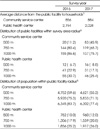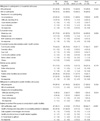Abstract
Objectives
The current survey environment is changing and participation rates in national nutrition surveys are decreasing. Therefore, the purpose of this study was to develop strategies for improving the nutrition survey system in the Korea National Health and Nutrition Examination Survey (KNHANES).
Methods
To develop an alternative system for conducting the KNHANES nutritional survey, we conducted focus group interviews with stakeholders of the survey, SWOT (Strengths, Weaknesses, Opportunities, and Threats) analysis, and expert reviews. In addition, spatial analysis of potential sites for conducting surveys instead of relying on household visits was performed, and the perception of nutritional surveys in the population eligible for KNHANES was evaluated.
Results
Based on the results of the focus group interviews, SWOT analysis, and expert reviews, we propose two options for survey sites: vehicles specifically prepared for nutritional surveys and public facilities such as community service centers or public health centers. Among public facilities, community service centers were found to be more appropriate sites than public health centers because they were considered more accessible. About 90% of respondents would participate in the survey in public facilities and about 74% would in vehicles.
Figures and Tables
Acknowledgments
*This research was supported by a grant from the Korea Centers for Disease Control and Prevention (No. 2017-E34010-00).
References
1. Kweon S, Kim Y, Jang MJ, Kim Y, Kim K, Choi S, et al. Data resource profile: The Korea National Health and Nutrition Examination Survey (KNHANES). Int J Epidemiol. 2014; 43(1):69–77.

2. Ministry of Health and Welfare, Korea Centers for Disease Control and Prevention. Korea national health and nutrition examination survey raw data use guidelines [Internet]. Korea Centers for Disease Control and Prevention;2015. updated 2017 Jan. cited 2018 Aug 8. Available from: https://knhanes.cdc.go.kr/knhanes/sub03/sub03_06_02.do.
3. Ikeda N, Takimoto H, Imai S, Miyachi M, Nishi N. Data resource profile: The Japan National Health and Nutrition Survey (NHNS). Int J Epidemiol. 2015; 44(6):1842–1849.

4. Public Health England, Food Standards Agency. Results of the National Diet and Nutrition Survey (NDNS) rolling programme for 2008 and 2009 to 2011 and 2012 [Internet]. Public Health England;2014. updated 2017 Feb 2. cited 2018 Aug 8. Available from: https://www.gov.uk/government/statistics/nationaldiet-and-nutrition-survey-results-from-years-1-to-4-combined-ofthe-rolling-programme-for-2008-and-2009-to-2011-and-2012.
5. Public Health England, Food Standards Agency. Results of the National Diet and Nutrition Survey (NDNS) rolling programme for 2012 to 2013 and 2013 to 2014 [Internet]. Public Health England;2016. cited 2018 Aug 8. Available from: https://www.gov.uk/government/statistics/ndns-results-from-years-5-and-6-combined.
6. Public Health England, Food Standards Agency. Results of the National Diet and Nutrition Survey (NDNS) rolling programme for 2014 to 2015 and 2015 to 2016 [Internet]. Public Health England;2018. cited 2018 Aug 8. Available from: https://www.gov.uk/government/statistics/ndnsresults-from-years-7-and-8-combined.
7. Centers for Disease Control and Prevention (CDC), National Center for Health Statistics (NCHS). National Health and Nutrition Examination Survey [Internet]. U.S. Department of Health and Human Services, Centers for Disease Control and Prevention;cited 2018 Aug 8. Available from: https://wwwn.cdc.gov/nchs/nhanes/ResponseRates.aspx.
8. Australian Bureau of Statistics. National health survey: Users' guide - electronic publication, 2007-08 [Internet]. Australian Bureau of Statistics;2009. updated 2012 Dec 6. cited 2018 Aug 8. Available from: http://www.abs.gov.au/AUSSTATS/abs@.nsf/Previousproducts/4363.0.55.001Main%20Features32007-08?opendocument&tabname=Summary&prodno=4363.0.55.001&issue=2007-08&num=&view=.
9. Australian Bureau of Statistics. Australian health survey: Users' guide, 2011-13 [Internet]. Australian Bureau of Statistics;2013. updated 2015 Mar 3. cited 2018 Aug 8. Available from: http://www.abs.gov.au/ausstats/abs@.nsf/Lookup/F87826FDF716EB94CA257B8D00229E83?opendocument.
10. Australian Bureau of Statistics. National health survey: Users' guide, 2014-15 [Internet]. Australian Bureau of Statistics;2017. updated 2017 Jul 28. cited 2018 Aug 8. Available from: http://www.abs.gov.au/ausstats/abs@.nsf/Lookup/by%20Subject/4363.0~2014-15~Main%20Features~Introduction~2.
11. Zipf GCM, Porter KS, Ostchega Y, Lewis BG, Dostal J. National health and nutrition examination survey: plan and operations, 1999-2010. Vital Health Stat 1. 2013; (56):1–37.
12. Kim MK, Kim K, Kim CI, Oh K, Oh YJ, Chol BY. The current status and the perspectives of nutrition survey. Korean J Epidemiol. 2007; 29(2):111–128.
13. Lee MJ. The improvement strategy for the survey methodology of community health survey. Korea Centers for Disease Control and Prevention;2014. 12. Report No. 11-1352159-000245-01.
14. Kim SW. A study on strategies for improving the 2015 community health survey performance monitoring. Korea Centers for Disease Control and Prevention;2016. 02. Report No. 11-1352159-000348-01.
15. Silverman D. Interpreting qualitative data: A guide to the principles of qualitative research. 4th ed. Los Angeles: Sage;2011. p. 57–86. .
16. Gurel E. SWOT Analysis: A theoretical review. J Int Soc Res. 2017; 10(51):994–1006.
17. Wade T, Sommer S. A to Z GIS: An illustrated dictionary of geographic information systems. 2nd ed. California: Esri Press;2006. p. 1–288.
18. Lee YS, Shon DW. A relationship analysis between subway transit demand and urban spatial characteristics in the subway station area. J Urban Des Inst Korea. 2012; 13(4):23–32.
19. Kim SY. Density management of subway station areas considering the identification of TOD planning factors: the case of Seoul, Korea [Master's thesis]. Hanyang University;2014.
20. Park SH, Shon DW, Lee JH. A spatial analysis of transit centers in Seoul metropolitan region for developing transit oriented urban environments. J Korean Soc Civ Eng. 2009; 29(1D):111–120.
21. Hwang GY. The outreach community centers initiative: Policy recommendations for improvement. Sejong: Korea Institute for Health and Social Affairs;2017. p. 115–123.




 PDF
PDF ePub
ePub Citation
Citation Print
Print







 XML Download
XML Download